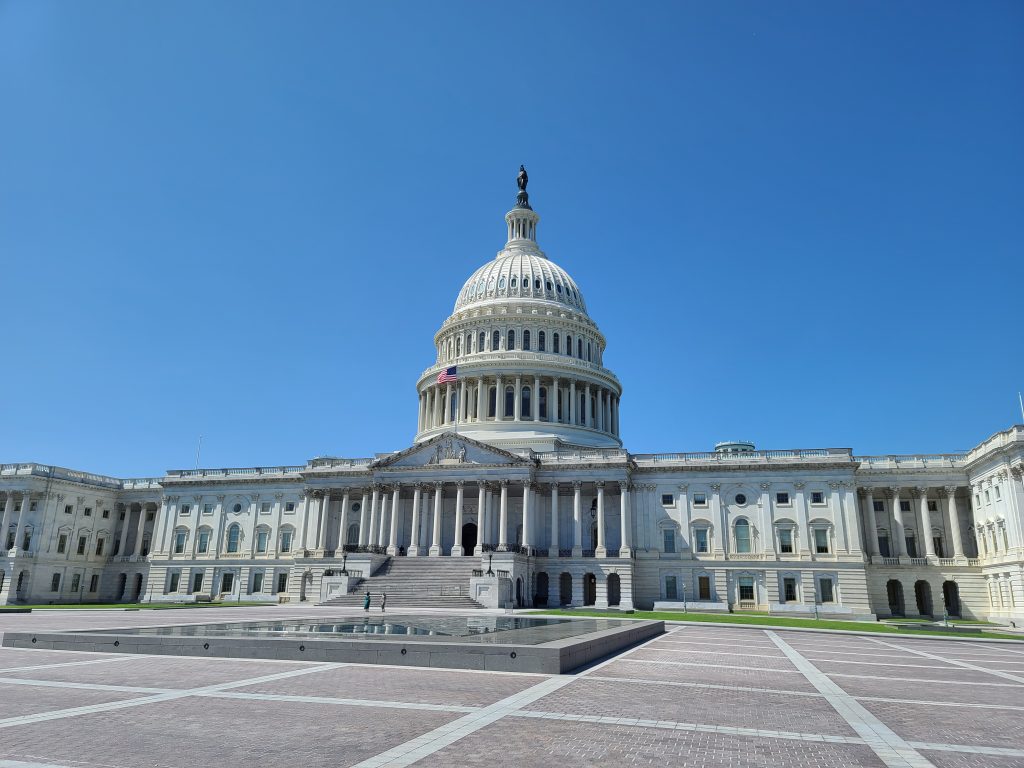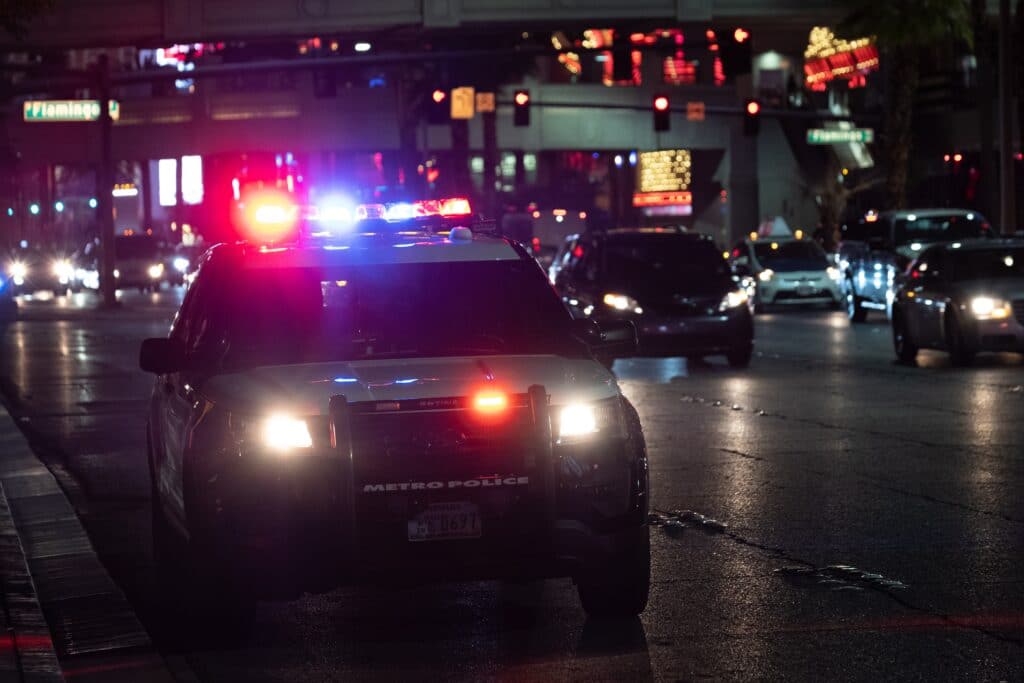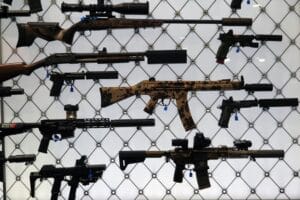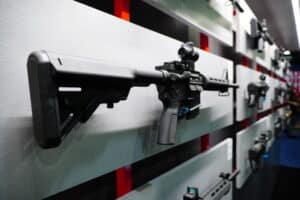I’m currently in Houston, Texas covering the NRA’s Annual Meeting.
The takeaway from my first two days here is that attendance is way down from previous years, but little else has changed. The NRA’s leadership and its invited speakers, especially former President Donald Trump, struck a defiant tone in the face of renewed calls for gun restrictions after the Uvalde shooting a few days earlier and a few hours drive from the convention center.
The show has featured somber moments with prayers for the victims and derision for the attacker. But the Leadership Forum where Trump spoke also had moments where it felt very much like any other NRA or Trump rally, complete with “let’s go Brandon” chants and t-shirts being tossed into the crowd. The Members Meeting was the same disorienting mix of fighting over parliamentary procedure and WWE-style speeches replete with entrance music and light shows it was back in 2019.
The main difference is that fewer people were there to take it all in. The Leadership Forum didn’t quite fill up a space that felt, at best, a bit bigger than a high school auditorium. The Members Meeting had maybe 200 people in attendance at its peak and dwindled to about the size it was during the rushed emergency event the NRA held in Charlotte, North Carolina last year after canceling the rest of the Annual Meeting.
That doesn’t mean the NRA’s opposition is necessarily gaining ground either. Besides the fact that no other gun group in the country could manage to put on an annual event of this scale, the protests outside of the George R. Brown Convention Center seemed poorly attended as well. From what I’ve seen thus far, they were on par with other NRA convention protests in the past.
It’s almost as though neither side of the gun debate was enthused about turning out at the NRA Annual Meeting this year.
As for policy responses to the recent mass shootings, nothing seems to have changed on that front either. There wasn’t any change of direction on gun policy and the famous line “the only thing that can stop a bad guy with a gun is a good guy with a gun” got repeated quite frequently. So, don’t expect the NRA to be driving any kind of grand bargain on mass shooting legislation.
Still, that doesn’t mean we won’t see legislation at either the federal or state levels. Contributing Writer Jake Fogelman takes a look at what Congress is doing right now as well as lawmakers in New York and Texas.
I also dive into the deeply disturbing law enforcement response to the Uvalde shooting. As more concrete details pour in, we’re learning that the police were properly trained to handle an active shooter but inexplicably did the exact opposite of what they were trained to do. Instead of rushing to confront the shooter, they waited upwards of an hour to take him out as multiple children inside the classroom he was in repeatedly pleaded with 911 for help.
Plus, we attempt to answer all of the Uvalde and NRA questions Reload members could come up with on this week’s podcast.

Analysis: The Proposals on the Table Following the Texas Shooting [Member Exclusive]
By Jake Fogelman
“Red flag” laws, expanded background checks, and “hardening” schools.
Amidst the public outcry following the attack on Robb Elementary School in Uvalde, Texas, a consensus seems to have formed around exploring proposals along these lines with new legislation.
A bipartisan group of senators—Chris Murphy (D., Conn.), Joe Manchin (D., W.Va.), Kyrsten Sinema (D., Ariz.), Martin Heinrich (D., N.M.), Richard Blumenthal (D., Conn.), Susan Collins (R., Maine), Pat Toomey (R., Pa.), Lindsey Graham (R., S.C.), and Bill Cassidy (R., La.)—met on Thursday to collaborate on versions of these proposals that might survive the evenly divided Senate.
Here’s a look at how these proposals appear to be shaping out.
Red Flag Bills
Red flag policies have reportedly drawn the most common ground during the discussions. Generally, they allow judges to issue special restraining orders that temporarily bar those found to be a threat to themselves or others from buying guns and require them to turn over any they already own.
Critics have pointed out that a federal red flag law would be unwieldy. The concern is that federal courts are not as well equipped as state and local courts to handle the volume of immediate-action hearings required by red-flag orders.
A more likely path would be for Congress to pass model red flag legislation, along with grant programs or other funding incentives for states to adopt the policy voluntarily. Preference for a state-driven approach has already been echoed by several Senate Republicans who have expressed interest in backing the temporary gun seizures.
19 states plus the District of Columbia already have versions of red flag legislation on the books. A concerted effort among states without red flag laws to join the others seems like a distinct possibility, with or without Congressional action.
Despite already having a version of the legislation on its books before the Buffalo Massacre, New York Governor Kathy Hochul (D.) has recently taken steps to expand its red flag law via executive order. She now wants to require police officers to request a red flag order anytime they have reasonable suspicion one is needed.
Even in Texas, despite Governor Greg Abbott’s recent rejection of calls for new gun laws, a push for some form of risk protection legislation is at least feasible. Fellow red-state Florida enacted the policy, becoming only the second red state to do so, following the Parkland shooting back in 2018. That same year, Governor Abbott expressed interest in having the Texas legislature explore the policy as part of his report on recommendations for school safety.
However, deeply held civil liberties concerns among many gun-rights advocates still present a significant obstacle to widespread take-up among red states. The use of ex parte orders, where the defendant is not provided an opportunity to dispute the order before it’s issued, and the low standard of evidence some states require remains a sticking point for many. Those concerns could deter Texas from pursuing the policy any further.
Background Checks
In March of last year, the House of Representatives passed a bill requiring background checks on all private gun transfers with limited exceptions and an extension of the time the FBI can delay a gun purchase before finalizing a background check. The bills have seen no movement in the Senate since then, but Majority leader Chuck Schumer (D., N.Y.) moved to fast track them for consideration on Wednesday. Neither bill is not expected to pass, though, with objections from even some Democrats.
Talk of reviving the 2013 Manchin-Toomey background check bill, which would have expanded background checks to include private sales but not all transfers, also appears to be taking place at the federal level. Senators Manchin, Toomey, and Mitt Romney (R., Utah) have all expressed openness to the idea thus far.
However, supporters of the move appear to be less sanguine about the prospects of it surviving a 60-vote threshold in the Senate. Senator Toomey told The Washington Post that it currently doesn’t have enough support in the Senate to pass.
The original version of the bill fell six votes short back in 2013. Despite helping to lead the charge for new gun laws in response to the attacks in Buffalo and Uvalde, Manchin has maintained that he will not sway from his support for keeping the filibuster in place. Unless eight more Republicans decide to join the effort to revive Manchin-Toomey, expanded background checks are unlikely to pass before the midterms.
School Security Measures
Several elected officials, primarily Republicans, have proposed reforms meant to “harden” or improve security at schools to defend against future attacks.
Senators Cynthia Lummis (R., Wyo.), Mike Rounds (R., S.D.), and Kevin Cramer (R., N.D.) have all called for the direction of COVID money or other federal funds to local school districts to improve police response times. Senator Murphy told The Washington Post that he was open to discussions within the bipartisan Senate group over increased funding for school security. But Democratic Senate leadership has largely thrown cold water on the idea preferring to focus on gun-control measures instead.
At the state level, Republicans in Texas have also emphasized the need to improve school security, drawing on a law passed by the state in 2019. That law instituted new emergency response plans for Texas schools, set training requirements for school resource officers, and established threat assessment protocols for identifying potentially dangerous students, among other reforms.
“We consider what we did in 2019 to be one of the most profound legislative sessions not just in Texas but in any state to address school shootings,” Governor Abbott said at a press briefing in Uvalde Wednesday. “But to be clear, we understand our work is not done. Our work must continue.”
No formal proposals have been advanced. However, given the state’s current political composition, it’s highly likely that additional GOP-backed school security measures will be advanced and implemented in the state soon.
The Likely Outcome
There is significant pressure on politicians at all levels to come up with new laws to prevent future massacres like the one at Robb Elementary School and Tops Grocery Store. That very well could lead to a breakthrough in Congress on some kind of legislation whether it’s in the form of a single policy or a major compromise bill made up of several policies favored by each side.
However, the state level remains the most likely to see proposals actually make it into law. And it’s likely that, as with current gun laws, they will significantly diverge from one another. New York will probably institute new gun restrictions while Texas focuses on hardening schools. Other states may follow suit along the same lines as well.
Podcast: Q&A on the NRA and Fallout From the Uvalde Shooting [Member Early Access]
By Stephen Gutowski
With so much going on this week it felt like the appropriate time to do another Q&A episode.
Contributing Writer Jake Fogelman joined me to answer some of the most pressing questions from Reload members. With the NRA Annual Meeting taking place in Houston, Texas just a few days after a horrific school shooting in Uvalde, Texas, there is a lot to discuss.
Members wanted to know how gun owners can best respond to attacks like this. What are some policy solutions? What’s the best way to avoid bad-faith fights without completely ceding the conversation to the loudest voices? Could the Uvalde or Buffalo attacks have been prevented under our current laws?
There were also several questions about the state of the NRA and the gun-rights movement at large. How bad have things gotten at the NRA? Are other gun-rights groups able to fill whatever gaps the NRA’s struggles have created? What lies ahead?
We answer those questions and more.
You can listen to the show on your favorite podcasting app or by clicking here.
You can also find the full episode on our YouTube channel.

Analysis: Police Inaction During the Uvalde Shooting is Inexplicable [Member Exclusive]
By Stephen Gutowski
As we learn more about how the attack on Robb Elementary School unfolded there are many questions where Americans will strongly disagree on the right solution, but one thing is becoming increasingly clear: the police response was utterly negligent.
Despite early reports indicating the shooter had to fight his way through police resistance in order to get into the school, it now appears nobody in law enforcement engaged him as he attempted to enter the school. In fact, the latest reporting from the Wall Street Journal indicates the shooter lingered outside the school for 12 minutes before entering. After an initial exchange of fire that left two officers injured as they arrived on the scene, police reportedly did not attempt to confront the shooter for upwards of an hour.
That is inexplicable. The response was so inept that a mother heard about the attack, drove 40 miles, confronted police who had not yet confronted the shooter, was handcuffed while trying to go into the school herself, got officers to remove the handcuffs, walked to a different area, climbed a fence and went inside. She was, miraculously, able to safely retrieve her children.
And all of that happened before police actually confronted the shooter.
“The police were doing nothing,” Angeli Rose Gomez, the mother in question, told the Journal. “They were just standing outside the fence. They weren’t going in there or running anywhere.”
This is a shocking deriliction of duty.
Responding to an active shooter event is something none of would want to have to do. It’s an exceedingly dangerous situation. I’ve never done it and I hope I never have to.
That said, I have taken several active shooter training courses over the years. One was with the Israeli Tactical School which was taught by a former Chief Security Officer in the Shin Bet. The other was a course for armed teachers in Colorado which was taught in part by a police officer who responded to a school shooting.
The key takeaway from both of those courses was the urgency of action. In an active shooter situation, every moment matters. Immediately moving towards the sound of gunfire is the priority, everything else is secondary.
If you allow a shooter uncontested time to carry out their attack, they will find more victims.
And this isn’t some grand revelation you need to attend multiple active shooter training drills to understand. This has been a well-known principle for literally decades now. It was one of the main takeaways from the Columbine shooting in 1999.
During that attack, police formed a perimeter outside the school and attempted to evacuate students from areas of the school where the shooters weren’t at. The assumption was the attack had become akin to a hostage situation. However, the delay in engaging the shooters merely allowed them to kill more students uncontested.
Somehow this mistake appears to have been repeated at Robb Elementary School. It’s difficult to comprehend how that could be the case. Instead of rushing in to confront the attacker, even after they had clearly gathered overwhelming force, police were tasked with tackling or tasing onlookers and parents who attempted to push past them to intervene themselves.
There is even a report that individual police officers entered the school to evacuate their own children.
Those parents knew what a deadly mistake waiting was. Why didn’t the people charged with making the decision on how to handle the attack? How could this possibly have been allowed to continue for so long?
It’s unconscionable.
We also have a report that indicates the shooter continued to kill children right up until the very moment he was shot by police. His attack did not end until he was killed himself. A fourth grade boy told a local outlet the attacker shot a little girl as she cried out to police for help when they finally did arrive in her classroom.
“When the cops came, the cop said: ‘Yell if you need help!’ And one of the persons in my class said ‘help.’ The guy overheard and he came in and shot her,” the boy told KENS 5. “The cop barged into that classroom. The guy shot at the cop. And the cops started shooting.”
It’s impossible to know how many children might have been saved if police had acted faster but it’s hard to imagine the number isn’t higher than zero given these facts.
The investigation is still ongoing and more details are likely to bring further clarity to what happened. However, it is impossible to imagine information coming out that justifies the inaction of law enforcement.
Further, this wasn’t a situation like the Parkland shooting where a single armed officer failed to intervene. This was bigger than that. Videos clearly show a significant police presence was on the scene for a significant amount of time before anyone was sent in to confront the shooter.
Who told those officers to secure a perimeter rather than find and neutralize the shooter?
This was a catastrophic leadership failure. We need answers for how this was allowed to happen. Who was responsible for making these decisions? And, for God’s sake, why did they make them?
That’s it for now.
I’ll talk to you all again soon.
Thanks,
Stephen Gutowski
Founder
The Reload







